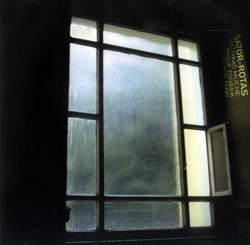
Here's a fairly infrequent and unusual occurrence: a trio of improvisers transposing the buzz of circuitry into the realms of the acoustic. Terre Thaemlitz tinkered with Kraftwerk's mensche-machine in similar fashion, trading in their German group's synthetic toys for the classical austerity of piano, with mixed results (he's done that deed with the likes of Devo as well). Now it's Marcus Schmickler's turn. Trombonist Muche, (prepared) pianist Zoubek, and bassist Tang attempt to reconfigure Schmickler's verdant electroacoustic work Sator Rotas into something more befitting a petite modern chamber ensemble. It's questionable whether or not such experiments should be conducted: it's easily understood why synthesists endeavor to reinterpret acoustic (usually classical) compositions by sculpting new motifs from arcs of electricity, but one wonders if it's a fool's gesture to navigate the opposite. Surely the very textures particular to electronic music's domain would be nigh on impossible to replicate in an unplugged setting; if anything, however, the nimble parameters of improvisation is the one genre capable of realizing such progeny successfully, theoretical obstacles notwithstanding.
Interestingly enough, the trio nearly pulls it off. Zoubek's occasional tone clusters and minimalist dabblings offer a spatial counterpoint to Tang's flanged contrabass, whose collection of squawks, scratches, peals, and sudden outbreaks create as much knotty tension as its electronic analog. Muche seems to be the odd man out at times, but there are numerous instances where his trombone provides a gaggle of alien contours that remind the listener what came first in the sonic narrative was the chicken before the egg. On the piece's third movement, Muche's outbursts feel like metamorphic rocks tumbling amongst Tang's gulf-streams of liquid metal, all flowing chop and offbeat hisses. All three musicians seem to not only possess a keen understanding of the parent material, but an intuitive concern about how, when and why certain sounds should be juxtaposed. They also subscribe to the maxim that silence is golden: in the recording's few deaf spots, enough inertia is attained so that when those gaps appear, it whets your appetite to see just where the piece will go next. When the whole enterprise assumes critical mass towards its denouement, the various fibrillations assuming a downright noisy position, the musicians are wise to let cacophony reign. The trio's got moxie, that's for sure, but it's all show, which ultimately classifies their take on Sator Ratos as a brave failure, pitched somewhere between lark and yeoman effort.
Comments and Feedback:



More Recent Reviews, Articles, and Interviews @ The Squid's Ear...


|

